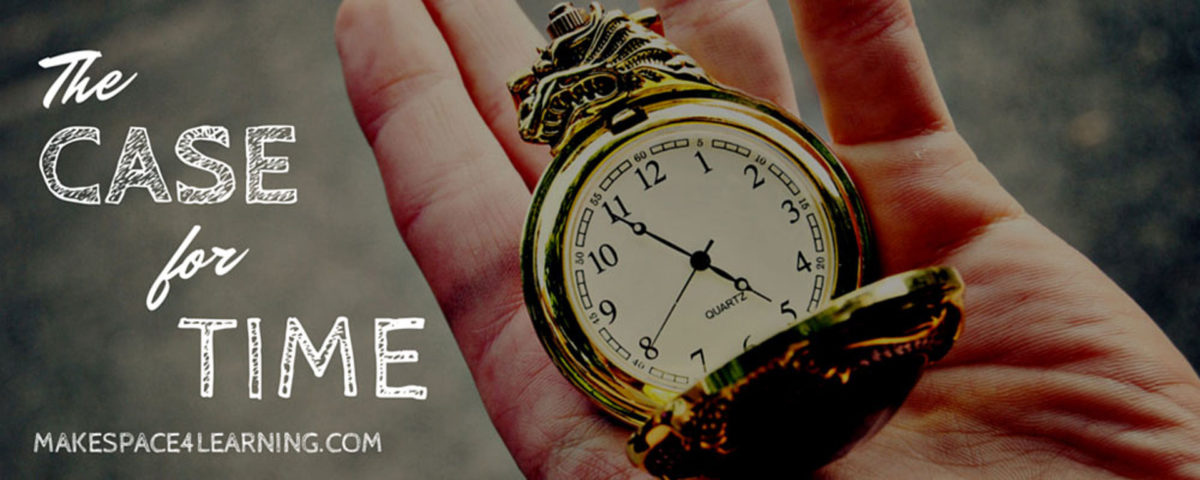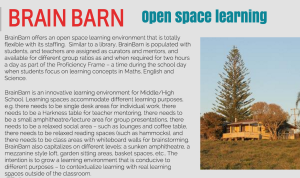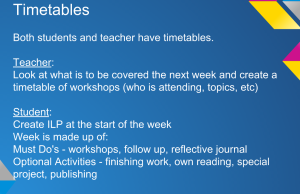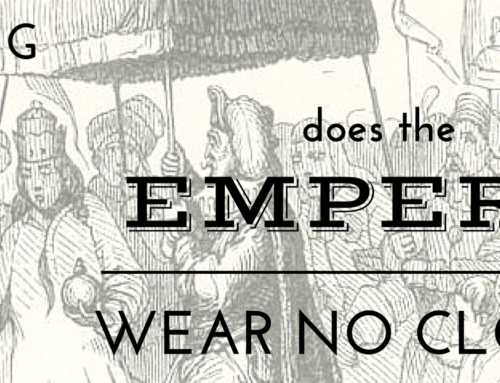 I recently read George Couros’ post expounding on the importance of not only space in modern learning environments, but also time. I couldn’t agree more with Corous’ thesis. I think that while the redesign of space has plenty of sizzle, without the re-thinking of time there’s no steak. Great spaces without the time to investigate them, co-construct their use and regularly reflect on their application are as misgiving as fancy wrapping paper on a pair of handerpants.
I recently read George Couros’ post expounding on the importance of not only space in modern learning environments, but also time. I couldn’t agree more with Corous’ thesis. I think that while the redesign of space has plenty of sizzle, without the re-thinking of time there’s no steak. Great spaces without the time to investigate them, co-construct their use and regularly reflect on their application are as misgiving as fancy wrapping paper on a pair of handerpants.
Couros’ describes his perspective on flexible timetabling coming from a public education system which mandates hours spent on particular disciplines.* He explains that he trusts his teachers to use their judgement and lets, for example, a mathematics period to roll over into a language block if students are engaged. This type of flexible thinking is imperative, and frankly a good hallmark of any transdisciplinary inquiry based school.
The concept of time tabling school differently, most famously came under fire in Sir Ken Robinson Changing Education Paradigms. Where in Robinson confronted our traditional cells and bells model of education:
But the model we have is this. I believe
we have a system of education that is modelled
on the interests of industrialism and in the image
of it. I’ll give you a couple of examples. Schools
are still pretty much organised on factory lines;
ringing bells, separate facilities, specialised into
separate subjects. We still educate children by
batches; we put them through the system by age
group – why do we do that? Why is there this
assumption that the most important thing kids
have in common is how old they are. It’s like the
most important thing about them is their date of
manufacture.
This ‘volley across the bow’, although likely played for nodding educators at faculty meeting across the globe, has done little to truly stir action in our schools. While many of our beliefs about why, how and where kids learn best have evolved, our institutional ways of organising our students have not.
While I have some personal ideas on innovative timetabling I’ll reserve my opinion for another post, perhaps till my thoughts are bit more action orientated. Meanwhile, here are some people and schools currently trying creative approaches to timetabling:
- Finnish schools, long lauded, for their creative approach to education and high test scores! (despite or in the face of a slight slip recently) have a unique vision of timetabling that values play. The day is broken into hour-long segments with 45 minutes of instruction followed by 15 minutes of play. These blocks provide brain breaks for students and support a number of the benefits of unstructured play.
- Former head of the Bali Green School John Stewart has another
interesting take on education. As part of his VAHS Learning Model (a holistic overhaul of schools) he sees a central component being the BrainBarn; an open space where students self pace within a curriculum and develop proficiency in language, mathematical or other concepts. Teachers become bookable mentors within the space as can students who achieved mastery. BrainBarn would be a daily block of at least two hours.
- Design thinking and learning spaces guru Ewan MacIntosh and his team at NoTosh have been working with schools to explore ways to make timetables working provide space for creative thinking. They have worked with students and teachers to identify the needs of select communities within the school whether that be extended class time for higher level students to explore mathematics concepts in greater depth or identifying collective down times in the week to re-engage students with “creative problem-finding projects”
- Often (with support from your admin- such as that demonstrated by
Couros) the greatest affect can be on a classroom basis. New Zealand teacher Amy McCauley’s detailed post on Individual Learning Pathways is such an example. When her school took on a 1 to 1 iPad programme McCauley asked how could this technology transform her classroom and empower her students. By creating a virtual learning environment she cracked the constraints of a traditional time table.
These are just a few of innovative ways educators are challenging the traditional norms of time tabling. What is your school up to?
Additional Reading: While a bit dated, ASCD’s 1990 article suggests some interesting ideas on timetabling.
*I do think as educators we often try to quantify professional judgement, be it through a timetable or a rubric rather than allowing our our intuition and prior knowledge guide us. I often wonder if other professionals, such as sports scouts use rubrics when evaluating amateur players.








